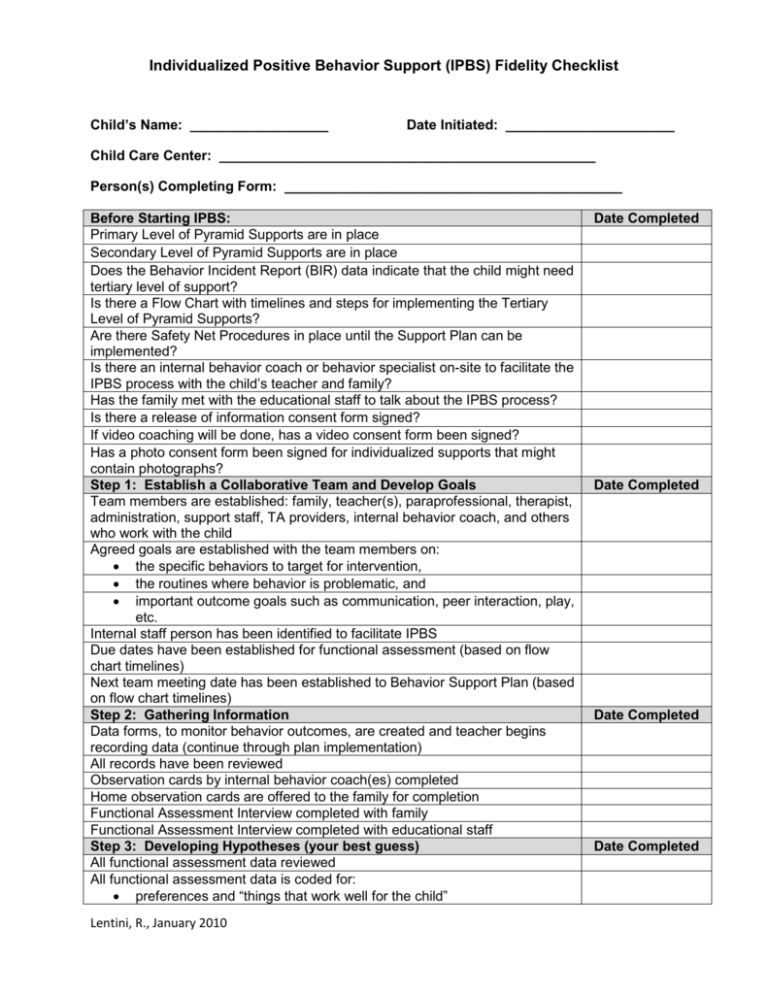Individualized Positive Behavior Support (IPBS) Fidelity Checklist
advertisement

Individualized Positive Behavior Support (IPBS) Fidelity Checklist Child’s Name: __________________ Date Initiated: ______________________ Child Care Center: _________________________________________________ Person(s) Completing Form: ____________________________________________ Before Starting IPBS: Primary Level of Pyramid Supports are in place Secondary Level of Pyramid Supports are in place Does the Behavior Incident Report (BIR) data indicate that the child might need tertiary level of support? Is there a Flow Chart with timelines and steps for implementing the Tertiary Level of Pyramid Supports? Are there Safety Net Procedures in place until the Support Plan can be implemented? Is there an internal behavior coach or behavior specialist on-site to facilitate the IPBS process with the child’s teacher and family? Has the family met with the educational staff to talk about the IPBS process? Is there a release of information consent form signed? If video coaching will be done, has a video consent form been signed? Has a photo consent form been signed for individualized supports that might contain photographs? Step 1: Establish a Collaborative Team and Develop Goals Team members are established: family, teacher(s), paraprofessional, therapist, administration, support staff, TA providers, internal behavior coach, and others who work with the child Agreed goals are established with the team members on: the specific behaviors to target for intervention, the routines where behavior is problematic, and important outcome goals such as communication, peer interaction, play, etc. Internal staff person has been identified to facilitate IPBS Due dates have been established for functional assessment (based on flow chart timelines) Next team meeting date has been established to Behavior Support Plan (based on flow chart timelines) Step 2: Gathering Information Data forms, to monitor behavior outcomes, are created and teacher begins recording data (continue through plan implementation) All records have been reviewed Observation cards by internal behavior coach(es) completed Home observation cards are offered to the family for completion Functional Assessment Interview completed with family Functional Assessment Interview completed with educational staff Step 3: Developing Hypotheses (your best guess) All functional assessment data reviewed All functional assessment data is coded for: preferences and “things that work well for the child” Lentini, R., January 2010 Date Completed Date Completed Date Completed Date Completed triggers behaviors maintaining consequences functions (purpose of behavior) Each purpose of behavior is written on a separate planning chart in the function box (e.g., escape transitions, escape a person, obtain a toy, obtain attention would each have its own chart) Triggers corresponding with each function are charted on the appropriate planning charts (see Support Planning Chart Form) Behaviors corresponding with each function are charted on the appropriate planning charts (see Support Planning Chart Form) Maintaining consequences corresponding with each function are charted on the appropriate planning charts (see Support Planning Chart Form) Each planning chart has all the components of a hypothesis: corresponding triggers, behaviors, maintaining consequences, and function (purpose of behavior) (see Support Planning Chart Form) Preferences and “things that work well for the child” are listed for use in the development of the support plan Step 4: Designing a Behavior Support Plan Each planning chart has: Prevention Strategies Replacement Skills to Teach Response Strategies for when the child uses the new replacement skills Response Strategies for when the challenging behavior occurs Safety Net Procedures (when needed) Action Plan is written to indicate who will prepare materials needed for plan implementation Behavior Support Plan is formally written using the planning charts to include: hypotheses statements, prevention strategies, replacement skills, and response strategies (including safety net procedures if needed) All materials needed for plan implementation are ready Step 5: Implementing, Monitoring, and Evaluating Outcomes and Refining the Plan in Natural Environments Teacher continues to record data on the data forms (developed in step 2) to monitor outcomes created Check-in dates with the team are scheduled Behavior Support Plan is implemented Team tracks progress with ongoing data collection Behavior Support Plan is evaluated Team amends plan as needed Team celebrates success! Lentini, R., January 2010 Date Completed Date Completed





